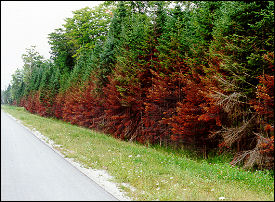
Category:Level 2 - Pollutants/Chloride
This page provides links to pages that provide information on chloride, on deicing, road salt, and other pages providing information related to these topics.
Chloride concentrations in stormwater runoff are highly variable, with very high concentrations in mid- to late-winter and early spring. The high concentrations are typically associated with salts used in road surface deicing agents and often exceed surface water and groundwater quality standards. Concentrations are much lower in summer but still elevated above natural background concentrations. Potential sources include runoff from soil, vegetative debris, automobile fluids, and animal wastes. Chloride is highly mobile in soil and will readily leach through the vadose zone and into groundwater.
At elevated concentrations, chloride can become toxic to aquatic life. Elevated levels of chloride can also result in low oxygen conditions, leading to the release of phosphorous and metals sorbed to the solids (Novotny et al., 2008). In addition, high levels of chloride will increase the density of the water, causing the salt containing water to settle to the bottom of the water body. This results in stratification and disrupts lake mixing patterns (New Hampshire Department of Environmental Services).
Pages in category "Level 2 - Pollutants/Chloride"
The following 84 pages are in this category, out of 84 total.
C
E
G
R
S
T
- TCMA Chloride Management Plan - Appendix A – TCMA Chloride TMDL
- TCMA Chloride Management Plan - Appendix A – TCMA Chloride Total Maximum Daily Loads (TMDLs)
- TCMA Chloride Management Plan - Appendix B – Winter Maintenance Assessment tool (WMAt)
- TCMA Chloride Management Plan - Appendix C – Sidewalk Survey Results
- TCMA Chloride Management Plan - Appendix D – Educational Resources
- TCMA Chloride Management Plan - Background and Description
- TCMA Chloride Management Plan - Monitoring, tracking, reporting, and adaptive management
- TCMA Chloride Management Plan - Prioritizing and Implementing Restoration and Protection
- TCMA Chloride Management Plan - Prioritizing and Implementing Restoration and Protection - Chloride reduction strategy
- TCMA Chloride Management Plan - Prioritizing and Implementing Restoration and Protection - Citizen attitudes and practices
- TCMA Chloride Management Plan - Prioritizing and Implementing Restoration and Protection - Citizens
- TCMA Chloride Management Plan - Prioritizing and Implementing Restoration and Protection - Cost considerations and funding opportunities
- TCMA Chloride Management Plan - Prioritizing and Implementing Restoration and Protection - Implementation strategies
- TCMA Chloride Management Plan - Prioritizing and Implementing Restoration and Protection - Minnesota Pollution Control Agency
- TCMA Chloride Management Plan - Prioritizing and Implementing Restoration and Protection - Municipalities
- TCMA Chloride Management Plan - Prioritizing and Implementing Restoration and Protection - Policy makers
- TCMA Chloride Management Plan - Prioritizing and Implementing Restoration and Protection - Prioritization and critical areas
- TCMA Chloride Management Plan - Prioritizing and Implementing Restoration and Protection - Secondary audiences
- TCMA Chloride Management Plan - Prioritizing and Implementing Restoration and Protection - Success stories
- TCMA Chloride Management Plan - Prioritizing and Implementing Restoration and Protection - Wastewater treatment facilities and industrial dischargers
- TCMA Chloride Management Plan - Prioritizing and Implementing Restoration and Protection - Water softeners
- TCMA Chloride Management Plan - Prioritizing and Implementing Restoration and Protection - Water treatment facilities (water supply)
- TCMA Chloride Management Plan - Prioritizing and Implementing Restoration and Protection - Watershed management organizations and districts and Soil and Water Conservation Districts
- TCMA Chloride Management Plan - Prioritizing and Implementing Restoration and Protection - Winter maintenance leadership (state, county, city, schools and private)
- TCMA Chloride Management Plan - Prioritizing and Implementing Restoration and Protection - Winter maintenance professionals (state, county, city, schools, parks, private)
- TCMA Chloride Management Plan - References
- TCMA Chloride Management Plan - Research Needs
- TCMA Chloride Management Plan - Stakeholder and Public Involvement Process
- TCMA Chloride Management Plan - TCMA Chloride Conditions
- TCMA Chloride Management Plan - TCMA Chloride Conditions - Chloride sources
- TCMA Chloride Management Plan - TCMA Chloride Conditions - Chloride trends
- TCMA Chloride Management Plan - TCMA Chloride Conditions - Condition status
- TCMA Chloride Management Plan - TCMA Chloride Conditions - Protection of surface and groundwater
- TCMA Chloride Management Plan - TCMA Chloride Conditions - TMDL summary
- TCMA Chloride TMDL - Applicable Water Quality Standards and Numeric Water Quality Targets
- TCMA Chloride TMDL - Executive Summary
- TCMA Chloride TMDL - Future Growth Consideration/Reserve Capacity
- TCMA Chloride TMDL - Impaired and High Risk Waterbodies by Location
- TCMA Chloride TMDL - Implementation Strategy Summary
- TCMA Chloride TMDL - Literature Cited
- TCMA Chloride TMDL - Monitoring Recommendations
- TCMA Chloride TMDL - NPDES Point Source Permits by Waterbody
- TCMA Chloride TMDL - Public Participation
- TCMA Chloride TMDL - Reasonable Assurance
- TCMA Chloride TMDL - TMDL Development
- TCMA Chloride TMDL - TMDL Tables
- TCMA Chloride TMDL - Water Quality Dashboards and Watershed Areas
- TCMA Chloride TMDL - Watershed and Waterbody Characterization
Media in category "Level 2 - Pollutants/Chloride"
The following 5 files are in this category, out of 5 total.
- Chloride water problem.pptx ; 52.73 MB
- Do we have a chloride problem in our.pptx ; 51.43 MB
- WRC conference trojan.pptx ; 18.54 MB
This page was last edited on 7 February 2023, at 14:22.
